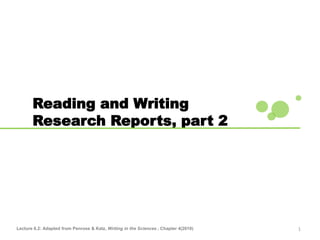
Chapter 4 Part 2
- 1. 1 Reading and Writing Research Reports, part 2 Lecture 6.2: Adapted from Penrose & Katz, Writing in the Sciences , Chapter 4(2010)
- 2. Reading and Writing Research Reports, part 1 Adapted from Penrose & Katz, Writing in the Sciences (2010) 2 1. Methods are traditionally described immediately following the introduction 2. An emerging trend is to place methods at the back, in smaller font, or as supplemental text online to save reading time for inspecting results (102) 3. Methods provide a framework within which the study’s results and conclusions were generated Describing Methods
- 3. Adapted from Penrose & Katz, Writing in the Sciences (2010) 3 4. Methods sections describe (for example—page 102)): a. Selection of subjects of study (people, locations, objects) b. Randomization and interventions c. Adherence to drugs d. Outcome measures e. Determination of sample size f. Statistical evaluation g. Experimental design 5. Methods presented in simple past tense, active or passive voice. Active is easier to follow, and more brief. Passive tends to remove the researchers from the work, pointing strictly to facts. (103) Describing Methods Reading and Writing Research Reports, part 1
- 4. Adapted from Penrose & Katz, Writing in the Sciences (2010) 4 Reading and Writing Research Reports, part 1 6. It is generally recognized that methods section cannot describe everything (103) 7. Standard, common procedures do not need to be cited; earlier procedures in previous studies do need to be cited; new procedures or substantial modifications need to be explained and justified. 8. Methods argues that the research design was sensibly constructed and conducted (103) 9. How you explain methods is crucial to your ethos as a scientist (103) Describing Methods
- 5. Adapted from Penrose & Katz, Writing in the Sciences (2010) 5 Reading and Writing Research Reports, part 1 Reporting Results 1. The Results section is where new evidence is presented to address the gap or question outlined in the introduction (105) 2. There is not space to record all raw data, requiring scientists to summarize data (105) 3. Results generalize data, pointing out trends. It is often best to place data in tables, then generalize and describe it, not just repeat it (See examples on pg. 106) a. “Fifty percent of the eradication group and 36% of the placebo group responded successfully to treatment in the intention-to-treat analysis (table 2)…” b. The proportion of patients who were considered a treatment success was significantly greater for the eradication arm than the placebo arm…”
- 6. Adapted from Penrose & Katz, Writing in the Sciences (2010) 6 Reading and Writing Research Reports, part 1 Reporting Results 4. Authors should refer readers to a visual explicitly and tell them the patterns to notice (example C106) a. “Table 3 show the impact of eradication treatment on disease specific measures of quality of life. The difference in the change in scores from pretreatment to study end showed significantly greater improvement…” 5. 88% of scientific articles in the 20th century include tables and figures (48% in the 19th century) (107) 6. Different kinds of visuals demonstrate different kinds of data (tables, bar charts, line graphs, photographs, diagrams, etc.) (107 – 108)
- 7. Adapted from Penrose & Katz, Writing in the Sciences (2010) 7 Reporting Results Reading and Writing Research Reports, part 1 7. Guidelines for visuals include: a. Figures must be independent, stand alone b. Figure titles should be as informative as possible c. Figure captions should be as informative as possible d. Figures should be interdependent with the text—they should help each other out e. Figures should be clearly referenced in the text and placed as close to the textual reference as possible (109) 8. Graphics should be self-explanatory, but you still need to let the reader know what you find interesting in the represented data (109)
- 8. Adapted from Penrose & Katz, Writing in the Sciences (2010) 8 1. Discussion explains how the research question posited in the introduction has been answered by the research. A new state of knowledge in the field is described (111) 2. Discussion is the place to: a. Summarize major findings, including their magnitude and direction of the effects b. Acknowledge advantages and limitations of the methods c. Outline research questions that remain (111) Discussing Trends and Implications Reading and Writing Research Reports, part 1
- 9. 9 Adapted from Penrose & Katz, Writing in the Sciences (2010) 9 3. Acknowledging limitation is crucial to show awareness. “Rebuttals” should be clearly expressed to acknowledge counterarguments (112) a. “Although some may argue that the lack of double- blinding introduced an important bias into our study, no objective data support such a contention…” (page 112) 4. Conclusions sometimes come after discussions, describing possible applications, policies, recommendations for clinicians, etc. 5. Researchers do not leave it up to the reader to draw conclusions—they tell them their conclusions Discussing Trends and Implications Reading and Writing Research Reports, part 1
- 10. 1010 Adapted from Penrose & Katz, Writing in the Sciences (2010) 10 6. Choice of verbs is important: suggest, indicate, show, demonstrate… (113) 7. Hedging verbs show that the scientist is aware that this data is true only within the boundaries of current knowledge (114) 8. Qualifying/hedging statements include: possibly, probably, very likely, necessarily, certainly,, without doubt, presumably, in all probability, hypothetically, maybe, certainly, without doubt… (114) Discussing Trends and Implications Reading and Writing Research Reports, part 1